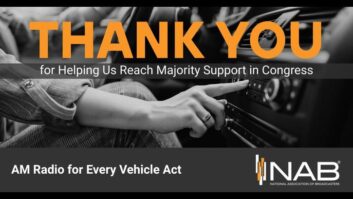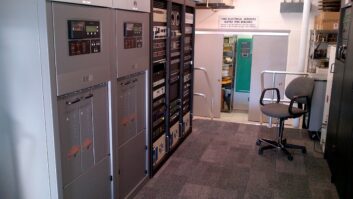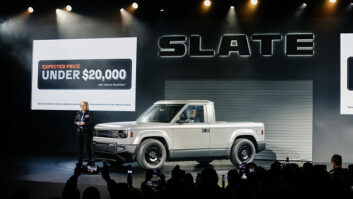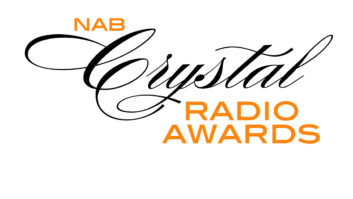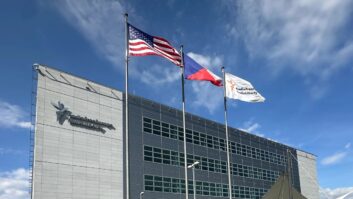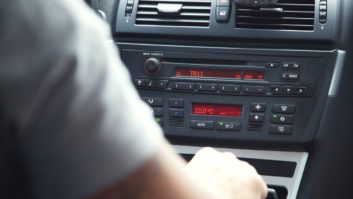The NAB Radio Show Daily News spoke with NAB President and CEO David K. Rehr about the organization and his thoughts about the future of the radio industry shortly before this year’s NAB Radio Show.
NAB Daily News: Over the last year NAB has been engaged in a pretty heated battle with the record labels. What is NAB doing to protect radio stations from having to pay a performance fee, and how do you assess your odds of success?
Rehr: NAB continues to use every tool at our disposal to protect America’s hometown radio stations from being taxed by the Recording Industry Association of America for the simple “privilege” of promoting their music. For decades local radio stations have provided the record labels and their artists with free promotion of their music. That promotion — heard by 235 million listeners a week — translates into increased album sales, and increased digital purchases, and has created the most successful recording industry in the world.
It simply defies logic for RIAA to now take aim at its members’ greatest promotional asset, essentially biting the hand that feeds it.
Over the past year, a majority of House lawmakers, joined by a dozen U.S. senators, have spoken out in opposition to a performance tax through the Local Radio Freedom Act. Given such strong congressional opposition to the label-led effort, we are cautiously optimistic that RIAA will fail to find enough support for their money-grab.
NAB Daily News: What are the next steps for Radio 2020?
Rehr: In April, we launched the latest phase of the Radio 2020 initiative — a campaign called Radio Heard Here — that includes a wide spectrum of promotional and educational initiatives designed to engage virtually the entire ecosystem that radio touches. With this campaign, we are reminding radio insiders, advertisers, the media industry and consumers of radio’s value.
Most recently, we launched a new, expanded Radio Heard Here Web site, RadioHeardHere.com, which provides a broad range of content aimed at engaging radio enthusiasts. We also launched several new tools — including a media kit, insider’s guide and accompanying PowerPoint — for radio insiders to use in their communication with advertisers, clients and listeners.
It is our hope — along with the hope of our partners at the Radio Advertising Bureau and the HD Digital Radio Alliance — that armed with the facts, tools and good news about radio, the entire radio community will join in this campaign to reinvigorate this great business and secure the successful future we can achieve together.
NAB Daily News: What is NAB doing to encourage implementation of radios into cell phones?
Rehr: Expanding radio service onto as many devices as possible is obviously a key initiative of ours at NAB. Our technology advocacy program, NAB FASTROAD, commissioned a study earlier this year highlighting the tremendous opportunities that would result from FM-capable cell phones. With 257 million cell phones currently in service, we’re confident that implementation of a new FM-radio feature would result in rapid penetration, benefiting not only the radio business and American consumers, but the cell phone, electronics manufacturing and music industries as well.
As we move forward, NAB will continue to aggressively advocate in support of new technological opportunities and we’re hopeful that electronics manufacturers and other technology service providers will come to more fully appreciate the value of integrating radio into their products.
NAB Daily News: What is your sense of how the broadcast localism initiative at the FCC will play out in coming months?
Rehr: NAB continues to work with the FCC on this issue in an effort to make sure commissioners more fully understand and appreciate how broadcasters serve their local communities and the negative impact this burdensome regulation would have on stations and their listeners and viewers. A one-size-fits-all regulation from Washington will not serve viewers and listeners who have come to rely on the timely and often lifesaving news and weather-related information provided by America’s radio and television stations.
Earlier this year, NAB placed a “call to action” on our Web site, encouraging member and nonmember stations to file comments with the FCC demonstrating their public service efforts and expressing their concerns over these onerous proposals.
We’re convinced that if broadcasters’ voices are heard, and a truly objective analysis is constructed, our decades-long record of public service will overshadow the small number of activists that erroneously claim broadcasters have abandoned our commitment to community.
NAB Daily News: Bruce Reese receives the NAB National Radio Award here. What’s your perspective on him and what Bonneville’s business approach means in today’s media world?
Rehr: Simply put, Bruce Reese is one of America’s great broadcasters. His leadership extends beyond just the radio business and permeates throughout his local community and in the many charitable organizations that he participates. As Bonneville’s leader, Bruce has embraced the “do good, do well” motto through exemplary public service programming and community service initiatives. His work at Bonneville has shown that the most successful radio stations are ones that cater to the needs of their local community. Furthermore, he has proven that providing your audience with quality programming and serving listeners with public service programs go hand-in-hand to produce profitable radio stations.
NAB Daily News: The overall U.S. economy is presenting challenges for all businesses, including radio. What is NAB doing to confront these challenges and what can radio stations do to strengthen their financial outlook?
Rehr: As the chief advocacy organization for America’s local radio and television stations, NAB works tirelessly to help create a regulatory climate that nurtures the growth of local broadcasting through continual dialog with policymakers. Educating Washing-ton on the essential and unique role played by local radio stations is a key ingredient in advancing and strengthening the radio business.
Ensuring a vibrant future also requires embracing technology and seeking new platform opportunities. Our future in this digital environment is incumbent upon our ability to adapt and thrive in this ever-changing climate. HD Radio is a great step forward, but we must also work to ensure radio programming is heard on every device out there — from the iPod to the cell phone. By strengthening and diversifying our offerings, we can increase radio’s value proposition to our 235 million weekly radio listeners.
©NAB

